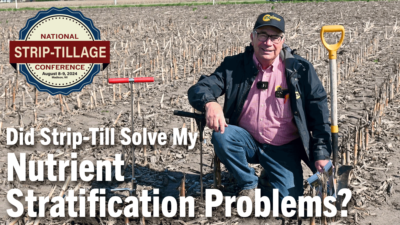With fall strip-tillers are hopefully taking advantage of a mild autumn in many areas to get berms built before winter permanently arrives, they are also assessing options to maximize biological value of corn residue.
Although the USDA is projecting corn production to be slightly down from record 2014 totals, there is still plenty of residue blanketing strip-tillers’ fields. Stillman Valley, Ill., farmer Cade Bushnell understands the challenges associated with efficiently managing residue, strip-tilling continuous corn in some fields for 6 years.
With about 80% highly erodible land (HEL) on his strip-tilled corn-on-corn fields, Bushnell says residue cover is critical to maintaining soil structure. But with annual corn yields averaging more than 200 bushels per acre, he also needs an effective strategy for breaking down residue.
“Planting for me starts with the combine,” he says. “Processing 200-245 bushels of residue is a lot, and in the past, I’ve had plugging issues with my strip-till rig. So I prefer that residue is chopped and spread.”
He uses Calmer Corn Heads’ BT Chopper technology to size and place residue during harvest, which concentrates residue in the old cornrows, rather than redistribute residue evenly across the field.
“I have a lot less residue to sweep out of the centers out of the row than I would if I had a lawnmower style chopping system,” Bushnell says.
Sizing residue is one step, and then properly placing it is the next. West Brooklyn, Ill., strip-tiller Dave Delhotal says it’s important to make sure the residue, however it’s cut, ends up at the base of the plant.
“It’s important for us to chop residue up into a nice confetti and we don’t want to leave long pieces of stalk laying out,” he says. “Sometimes they will get grabbed up by coulters on a strip-till rig and thrown back on top of the strip.”
Of course, leaving stalks standing is a more practical option for some strip-tillers, to ensure there’s enough residue cover to provide a biological benefit. Bruning, Neb., strip-tiller Jerry Baysinger says having a little height in the field can help catch blowing residue, rather the risk having it pile up in certain areas.
“In the past, we’ve had drifts of residue 2 or 3 feet high in ditches because of strong winds and we need to prevent that,” he says. “Standing stalks also catch and hold the snow. If we keep it on the field, it’s free moisture, and when it melts it helps the decomposition process too.”
What is your most effective residue management practice? Share your perspective with me at (262) 777-2441, or send me an e-mail at jzemlicka@lesspub.com.







Post a comment
Report Abusive Comment